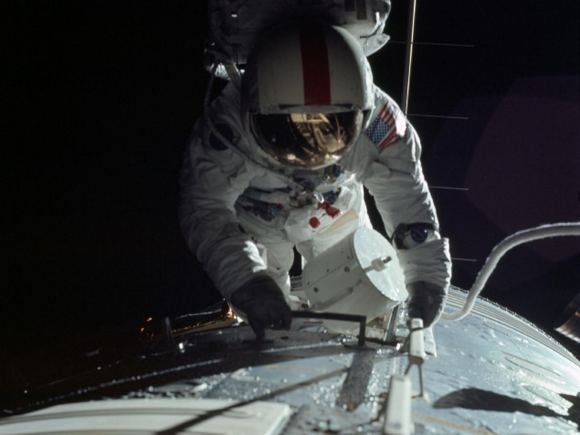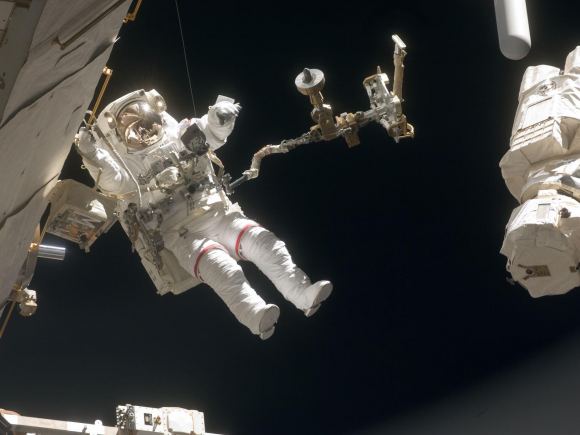Living and working in space for extended periods of time is hard work. Not only do the effects of weightless take a physical toll, but conducting spacewalks is a challenge in itself. During a spacewalk, astronauts can become disoriented, confused and nauseous, which makes getting home difficult. And while spacewalks have been conducted for decades, they are particularly important aboard the International Space Station (ISS).
Hence why the Charles Stark Draper Laboratory (aka. Draper Inc.), a Massachusetts-based non-profit research and development company, is designing a new spacesuit with support from NASA. In addition to gyroscopes, autonomous systems and other cutting-edge technology, this next-generation spacesuit will feature a “Take Me Home” button that will remove a lot of the confusion and guesswork from spacewalks.
Spacewalks, otherwise known as “Extra-Vehicular Activity” (EVA), are an integral part of space travel and space exploration. Aboard the ISS, spacewalks usually last between five and eight hours, depending on the nature of the work being performed. During a spacewalk, astronauts use tethers to remain fixed to the station and keep their tools from floating away.
Another safety feature that comes into play is the Simplified Aid for EVA Rescue (SAFER), a device that is worn by astronauts like a backpack. This device relies on jet thrusters that are controlled by a small joystick to allow astronauts to move around in space in the event that they become untethered and float away. This device was used extensively during the construction of the ISS, which involved over 150 spacewalks.
However, even with a SAFER on, it is not difficult for an astronaut to become disoriented during and EVA and lose their bearings. Or as Draper engineer Kevin Duda indicated in a Draper press statement, “Without a fail-proof way to return to the spacecraft, an astronaut is at risk of the worst-case scenario: lost in space.” As a space systems engineer, Duda has studied astronauts and their habitat on board the International Space Station for some time.
He and his colleagues recently filed a patent for the technology, which they refer to as an “assisted extravehicular activity self-return” system. As they described the concept in the patent:
“The system estimates a crewmember’s navigation state relative to a fixed location, for example on an accompanying orbiting spacecraft, and computes a guidance trajectory for returning the crewmember to that fixed location. The system may account for safety and clearance requirements while computing the guidance trajectory.”

In one configuration, the system will control the crew member’s SAFER pack and follow a prescribed trajectory back to a location designated as “home”. In another, the system will provide directions in the form of visual, auditory or tactile cues to direct the crew member back to their starting point. The crew member will be able to activate the system themselves, but a remote operator will also be able to turn it on if need be.
According to Séamus Tuohy, Draper’s director of space systems, this type of return-home technology is an advance in spacesuit technology that is long overdue. “The current spacesuit features no automatic navigation solution—it is purely manual—and that could present a challenge to our astronauts if they are in an emergency,” he said.
Such a system presents multiple challenges, not the least of which has to do with Global Positioning Systems (GPS), which are simply not available in space. The system also has to compute an optimal return trajectory that accounts for time, oxygen consumption, safety and clearance requirements. Lastly, it has to be able to guide a disoriented (or even unconscious astronaut) effectively back to their airlock. As Duda explained:
“Giving astronauts a sense of direction and orientation in space is a challenge because there is no gravity and no easy way to determine which way is up and down. Our technology improves mission success in space by keeping the crew safe.”

The solutions, as far as Duda and his colleagues are concerned, is to equip future spacesuits with sensors that can monitor the wearer’s movement, acceleration, and relative position to a fixed object. According to the patent, this would likely be an accompanying orbiting spacecraft. The navigation, guidance and control modules will also be programmed to accommodate various scenarios, ranging from GPS to vision-aided navigation or star tracking.
Draper has also developed proprietary software for the system that fuses data from vision-based and inertial navigation systems. The system will further benefit from the company’s extensive work in wearable technology, which also has extensive commercial applications. By developing spacesuits that allow the wearer to obtain more data from their surroundings, they are effectively bringing augmented reality technology into space.
Beyond space exploration, the company also foresees applications for their navigation system here at home. These include first responders and firefighters who have to navigate through smoke-filled rooms, skydivers falling towards the Earth, and scuba divers who might become disoriented in deep water. Literally any situation where life and death may depend on not getting lost could benefit from this technology.
Further Reading: Draper, Google Patents

